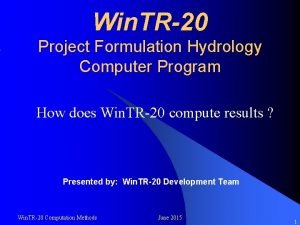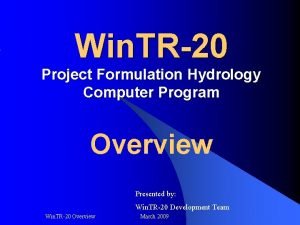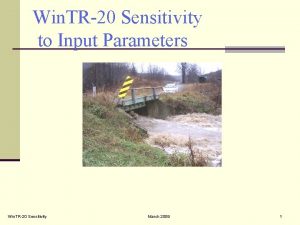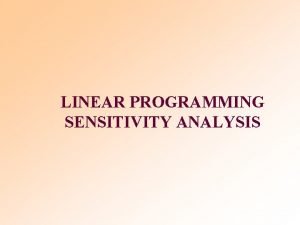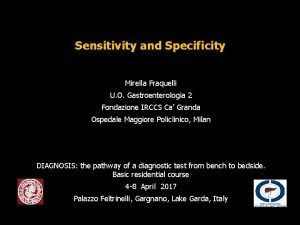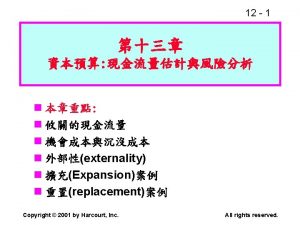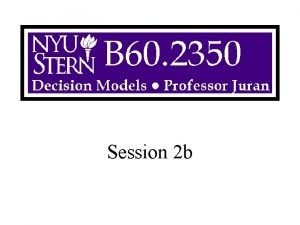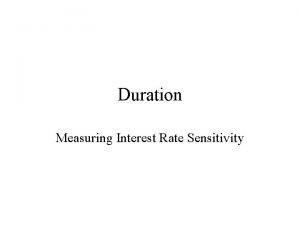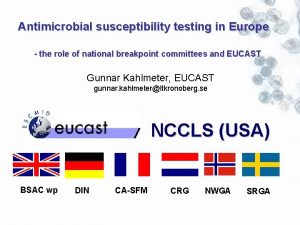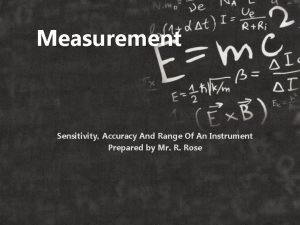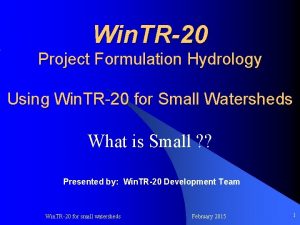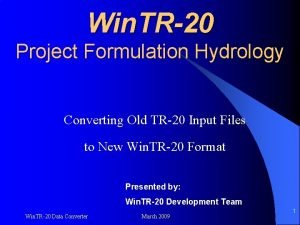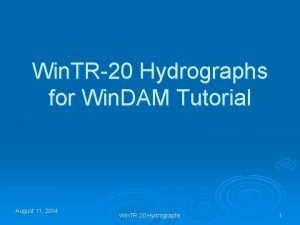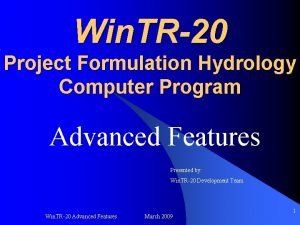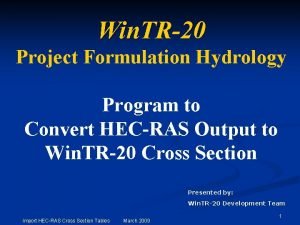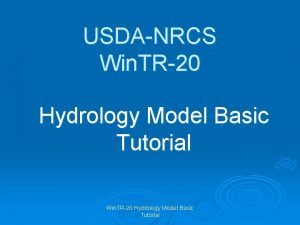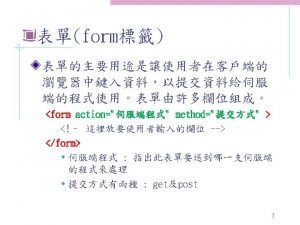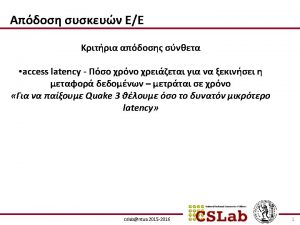Win TR20 Sensitivity to Input Parameters Win TR20




























- Slides: 28

Win. TR-20 Sensitivity to Input Parameters Win. TR-20 Sensitivity March 2009 1

Lesson Objectives 1. Identify the various Win. TR-20 Input Parameters that affect the volume of runoff and peak discharge predictions. 2. Identify the relative sensitivity of Win. TR-20 to its input parameters in predicting the peak and/or volume of runoff. 3. Identify the relative sensitivity of Win. TR -20 to its input parameters in relation to channel routing. Win. TR-20 Sensitivity March 2009 2

Win. TR-20 Hydrology Model n Predicts Volume of Runoff n Predicts Peak Rate of Runoff n Predicts Entire Hydrograph of Runoff n Based on Watershed and Rainfall Characteristics Modeled as Input Parameters n Changes to Input Parameters Will Change the Volume and Rate of Runoff Predicted Win. TR-20 Sensitivity March 2009 3

Win. TR-20 Watershed Input Variables n Drainage Area n Runoff Curve Number (RCN) n Time of Concentration (tc) n Unit Peak Factor (UPF) of Dimensionless Unit Hydrograph (DUH) n Antecedent Runoff Condition (ARC) Win. TR-20 Sensitivity March 2009 4

Win. TR-20 Rainfall Input Variables n Depth of Rainfall n Rainfall Distribution (includes duration) Win. TR-20 Sensitivity March 2009 5

Effects of Variation in Drainage Area n % Change in DA results in comparable change to predicted volume and peak of runoff. n Be sure DA is being properly identified (be aware of non-contributing areas). Win. TR-20 Sensitivity March 2009 6

Effects of Variation in RCN n % Change in RCN results in exaggerated change to predicted volume and peak of runoff. n RCN can be influenced by stage of vegetal growth and/or antecedent rainfall at time of storm event. Win. TR-20 Sensitivity March 2009 7

Effects of Variation in tc n % Change in tc results in decreased change to predicted peak rate of runoff (no change in volume). n A decrease in tc results in an increase in predicted peak discharge. Win. TR-20 Sensitivity March 2009 8

Effects of Variation in Unit Peak Factor n % Change in UPF results in nearly similar change to predicted peak rate of runoff (no change in volume). n UPF is a watershed based response to excess rainfall assumed to be similar per inch of runoff. Win. TR-20 Sensitivity March 2009 9

Effects of Variation in Antecedent Runoff Condition (ARC) n ARC values of 1 or 3 alter the RCN selected for assumed ARC 2 conditions. n ARC 2 is normally assumed for design. n ARC 1 can be used to help calibrate for a known “drought” condition prior to the target storm event (not necessarily accurate). n ARC 3 can be used to help calibrate for a known “saturated soil” condition prior to the target storm event (not necessarily accurate). Win. TR-20 Sensitivity March 2009 10

ARC Adjustments (Continued) n For this example: DA = 1. 0 mi 2, tc = 1 hr, RCN = 70, 4. 0 inch 24 hr Type II Rainfall n n n ARC 2 – (RCN 70), Qv = 1. 33”, Qp = 437 cfs ARC 1 – (RCN 51), Qv = 0. 37”, Qp = 65 cfs ARC 3 – (RCN 85), Qv = 2. 46”, Qp = 874 cfs n Win. TR-20 results are very sensitive to changes in ARC. Be sure that assumed change is appropriate or alter RCN within ARC 2 conditions for finer adjustment. Win. TR-20 Sensitivity March 2009 11

Effects of Variation in Rainfall Depth n % Change in Rainfall Depth results in exaggerated change to predicted volume and peak of runoff. n Be sure that the actual Rainfall that has occurred and is being calibrated to is properly identified for the entire watershed. Win. TR-20 Sensitivity March 2009 12

Effects of Variation in Rainfall Distribution n Design rainfall distributions normally set by criteria (e. g. Type I, IA, II, or III). n Can attempt to calibrate to a historical rainfall event of known varying intensity (recording rain gage). n Rainfall distribution alone (not depth) only effects the rate of runoff, not the volume. Win. TR-20 Sensitivity March 2009 13

Effects of Variation in Rainfall Distribution (Continued) n For this example: DA = 1. 0 mi 2, tc = 1 hr, RCN = 70, 4. 0 inch 24 hr Type II Rainfall n n Type II - Qp = 437 cfs Type I - Qp = 221 cfs Type IA - Qp = 106 cfs Type III - Qp = 383 cfs n Win. TR-20 peaks are very sensitive to selection of rainfall distribution. Calibrate with the best known rainfall distribution. Win. TR-20 Sensitivity March 2009 14

Parameter Selection for Desired Change in Win. TR-20 Runoff Volume Desired Change in Runoff Volume (%) Win. TR-20 Parameter to be Changed, Independent of Others -50% -25% -10% -5% +10% +25% +50% Required Change in Drainage Area -50% -25% -10% -5% +10% +25% +50% Required Change in Rainfall -26% -13% -5% -2. 5% +5% +12. 5% +23% Required Change in RCN -17% -8% -2% -1% +2% +7% +13% Required Change in Time of Concentration N/C N/C Required Change in Unit Peak Factor N/C N/C N/C signifies, No Change possible to alter volume. This parameter does not effect volume prediction. Win. TR-20 Sensitivity March 2009 15

Parameter Selection for Desired Change in Win. TR-20 Peak Runoff Desired Change in Runoff Peak (%) Win. TR-20 Parameter to be Changed, Independent of Others -50% -25% -10% -5% +10% +25% +50% Required Change in Drainage Area -50% -25% -10% -5% +10% +25% +50% Required Change in Rainfall -24% -12% -5% -2. 50% +2. 5% +11% +21% Required Change in RCN -13. 5% -6% -2% -1% +2% +5. 5% +11% Required Change in Time of Concentration +150% +15% +7% -6% -12% -26. 5% -44% -54% -29% -12% -6% +13% +33% +72% Required Change in Unit Peak Factor Win. TR-20 Sensitivity March 2009 16

Combined Parameter Impacts n Assumed Normal Run n DA = 1 mi 2, RCN =70, tc = 1. 0 hr, UPF = 484 n Runoff Volume = 1. 33”, Peak Rate = 437 cfs n Low Run n DA = 1 mi 2, RCN =63, tc = 1. 25 hr, UPF = 300 n Runoff Volume = 0. 92”, Peak Rate = 148 cfs n High Run n DA = 1 mi 2, RCN =77, tc = 0. 75 hr, UPF = 600 n Win. TR-20 Sensitivity Runoff Volume = 1. 81”, Peak Rate = 904 cfs March 2009 17

Win. TR-20 Channel Routing Model n Predicts hydrograph (including peak) at downstream end of reach. n Based on cross section and reach characteristics modeled as input parameters. n Changes to input parameters will change the peak discharge and hydrograph shape predicted at the end of the reach. Win. TR-20 Sensitivity March 2009 18

Win. TR-20 Channel and Reach Input Variables n Selection of representative cross section n Cross section rating table (slope and “n”) n Channel length n Flood plain length n Shape of inflow hydrograph n Base flow (if significant) Win. TR-20 Sensitivity March 2009 19

Win. TR-20 Channel Routing Sensitivity Test n Trapezoidal cross section, BW = 15, SS = 2: 1 n Slope = 0. 001 and 0. 004 n Manning n = 0. 03, 0. 04, 0. 05 n Channel length, 0. 8 to 1. 2 mile n Inflow hydrograph, DA = 1, CN = 80, Tc = 0. 5 and 1. 0, RF = 3. 2 inches, Type II storm n Base flow = 0. 0 n 60 Win. TR-20 runs Win. TR-20 Sensitivity March 2009 20

Two Inflow hydrographs n Red (higher) is the hydrograph for Tc = 0. 5 hour. n Green (lower) is the hydrograph for Tc = 1. 0 hour. Win. TR-20 Sensitivity March 2009 21

Effects of Variation in Length and “n” n % Change in length results in less change to predicted peak outflow. n % Change in Manning “n” results in less change to predicted peak outflow. Win. TR-20 Sensitivity March 2009 22

Effects of Variation in Length and “n” n % Change in length and “n” results in less change to predicted peak outflow. n Length and “n” less sensitive for Tc = 1. 0 hydrograph. Win. TR-20 Sensitivity March 2009 23

Effects of Variation in Length and “n” n % Change in length and “n” results in less change to predicted peak outflow. n Results for steep slope are less sensitive. Win. TR-20 Sensitivity March 2009 24

Effects of Variation in Length and “n” n % Change in length and “n” results in less change to predicted peak outflow. n Results for Tc = 1. 0 hydrograph are even less. Win. TR-20 Sensitivity March 2009 25

Porcupine Mountains State Park, Michigan Win. TR-20 Sensitivity March 2009 26

Questions? ? ? Win. TR-20 Sensitivity March 2009 27

The End Win. TR-20 Sensitivity March 2009 28
 Win tr20
Win tr20 What is tr20
What is tr20 Win tr 20
Win tr 20 Win tr 20
Win tr 20 Win tr20
Win tr20 Win tr20
Win tr20 Win-lose attitude
Win-lose attitude Win win win lose lose lose
Win win win lose lose lose Win-win win-lose lose-lose
Win-win win-lose lose-lose Win-win negotiations are also known as
Win-win negotiations are also known as Win win situation examples conflict resolution
Win win situation examples conflict resolution Example of a win win situation
Example of a win win situation Five dimensions of win win
Five dimensions of win win Win win strategies
Win win strategies Habit 4 examples
Habit 4 examples Win win nacin placanja
Win win nacin placanja Think win win examples
Think win win examples Win win or no deal
Win win or no deal Perangkat output
Perangkat output Finely tuned input and roughly tuned input
Finely tuned input and roughly tuned input Sensitivity analysis
Sensitivity analysis Fluctuating load example
Fluctuating load example Sensitivity vs specificity
Sensitivity vs specificity Scenario analysis中文
Scenario analysis中文 Decision models
Decision models Interest rate risk sensitivity analysis
Interest rate risk sensitivity analysis Antifungal sensitivity test
Antifungal sensitivity test Minimum discriminable acuity
Minimum discriminable acuity Sensitivity of an instrument
Sensitivity of an instrument

